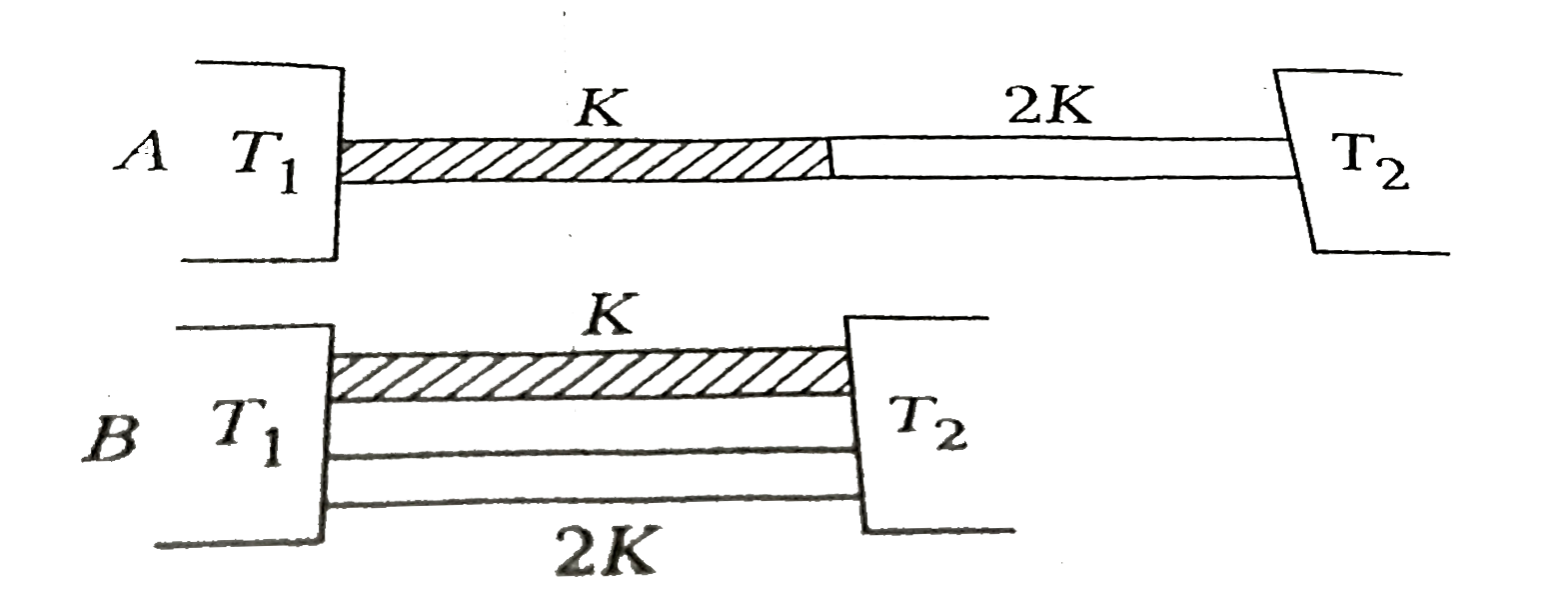Two bodies A and B having same angular momentum and IA>IB, then the relation between (K.E.)Aand(K.E.)B will be :
(K.E.)A>(K.E.)B
(K.E.)A=(K.E.)B
(K.E.)A<(K.E.)B
(K.E.)A1(K.E.)B
The correct Answer is:3
To solve the problem, we need to analyze the relationship between the angular momentum and kinetic energy of two rotating bodies A and B, given that they have the same angular momentum and that the moment of inertia of A is greater than that of B.
1. Understand Angular Momentum:
The angular momentum L of a rotating body is given by the formula:
L=Iω
where I is the moment of inertia and ω is the angular velocity.
2. Given Conditions:
We know that:
- LA=LB (same angular momentum for both bodies)
- IA>IB (moment of inertia of A is greater than that of B)
3. Express Angular Velocity:
From the angular momentum formula, we can express the angular velocities of A and B:
ωA=LAIAandωB=LBIB
Since LA=LB, we can write:
ωA=LIAandωB=LIB
4. Kinetic Energy of Rotating Bodies:
The kinetic energy K.E. of a rotating body is given by:
K.E.=12Iω2
Substituting the expressions for angular velocity, we get:
K.E.A=12IA(LIA)2=L22IA
K.E.B=12IB(LIB)2=L22IB
5. Compare Kinetic Energies:
Now we can compare the kinetic energies:
K.E.A=L22IAandK.E.B=L22IB
Since IA>IB, it follows that:
1IA<1IB
Therefore:
K.E.A<K.E.B
6. Conclusion:
The relation between the kinetic energies of the two bodies is:
K.E.A<K.E.B
Final Answer:
The kinetic energy of body A is less than the kinetic energy of body B, i.e., K.E.A<K.E.B.
The angular momentum L of a rotating body is given by the formula:
L=Iω
where I is the moment of inertia and ω is the angular velocity.
We know that:
- LA=LB (same angular momentum for both bodies)
- IA>IB (moment of inertia of A is greater than that of B)
From the angular momentum formula, we can express the angular velocities of A and B:
ωA=LAIAandωB=LBIB
Since LA=LB, we can write:
ωA=LIAandωB=LIB
The kinetic energy K.E. of a rotating body is given by:
K.E.=12Iω2
Substituting the expressions for angular velocity, we get:
K.E.A=12IA(LIA)2=L22IA
K.E.B=12IB(LIB)2=L22IB
Now we can compare the kinetic energies:
K.E.A=L22IAandK.E.B=L22IB
Since IA>IB, it follows that:
1IA<1IB
Therefore:
K.E.A<K.E.B
The relation between the kinetic energies of the two bodies is:
K.E.A<K.E.B
The kinetic energy of body A is less than the kinetic energy of body B, i.e., K.E.A<K.E.B.
Topper's Solved these Questions
- SYSTEM OF PARTICLES AND ROTATIONAL MOTIONBook:VMC MODULES ENGLISHChapter:SYSTEM OF PARTICLES AND ROTATIONAL MOTIONExercise:EFFICIENT
Explore 50 Videos
- SYSTEM OF A PARTICLES & ROTATIONAL MOTIONBook:VMC MODULES ENGLISHChapter:SYSTEM OF A PARTICLES & ROTATIONAL MOTIONExercise:IN-CHAPTER EXERCISE F
Explore 10 Videos
- UNITS, MEASUREMENTS & ERRORSBook:VMC MODULES ENGLISHChapter:UNITS, MEASUREMENTS & ERRORSExercise:IN - CHAPTER EXERCISE - B
Explore 10 Videos
Similar Questions
Two rigid bodies A and B rotate with angular momenta LA and LB respectively. The moments of inertia of A and B about the axes of rotation are IA and IB respectively. If IA=IB/4 and LA=5LB, then the ratio of rotational kinetic energy KA of A to the rotational kinetic energy KB of B is given by
View Solution(i) If A and B are two complementary events then what is the relation between P(A) and P(B) ?
View Solution
Knowledge Check
If momentum of a certain body is increased by 50% then increase in the K.E. of the body will be
A0.25B0.5C1D1.25
Two bodies A and B made of same material have the moment of inertial in the ratio IA:IB=16:18 The ratio of the masses mA:mB is given by a) cannot be obtained b) 2:3 c) 1:1 d) 4:9
View SolutionIf momentum is increased by 20% , then K.E. increase by
View SolutionIf loge(a+b2)=12(logea+logeb), then find the relation between aandb.
View SolutionTwo rotating bodies A and B of masses m and 2m with moments of inertia IA and IB(IB>IA) have equal kinetic energy of rotation. If LA and LB be their angular momenta respectively, then
View SolutionTwo rods with the same dimensions have thermal conductivities in the ratio 1 : 2. they are arranged between heat reservoirs with the same temperature difference, in two different configurations, A and B. The rates of heat flow in A and B are IAandIB respectively. The ratio IAIB) is equal to

View SolutionTwo electric lamps A and B radiate the same power. Their filaments have the same diemensions, and have emissivities. eA and eB. Their surface tempratures are TA an TB. The ratio TA/TB will be equal to
View SolutionTwo electrons in two hydrogen - like atoms A and B have their total energies EA and EB in the ratio EA:EB=1:2. Their potential energies UA and UB are in the ratio UA:UB=1:2. If λA and λB are their de-Broglie wavelengths, then λA:λB is
View Solution
